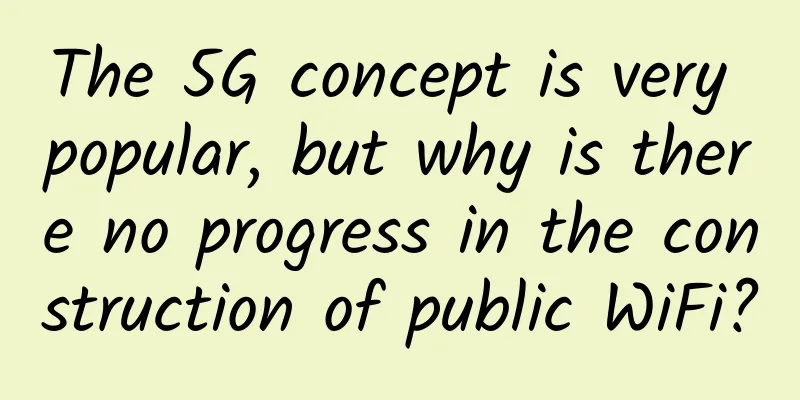The 5G concept is very popular, but why is there no progress in the construction of public WiFi?

|
Since 2015, the country has begun to continuously emphasize the importance of broadband construction and network development, and has also issued documents related to network speed increase and fee reduction. Since then, under the strong promotion of the Ministry of Industry and Information Technology, the three major domestic operators finally launched unlimited data cards this year. However, the situation is not optimistic for the construction of public WiFi. 16WiFi, which set a new record in the WiFi field with 300 million in round B financing last year, was forced to stop business in 11 cities in February this year due to funding problems, leaving only Beijing and Kunming as model cities. There has been no good news about the construction of other public WiFi, but from time to time, people have reported that the speed of public WiFi is too slow. On the one hand, the pace of mobile data speed increase and fee reduction is accelerating, while on the other hand, the construction of public WiFi is struggling. So when the concept of 5G is hot, why is there no progress in the construction of public WiFi? Is the development of mobile data one of the obstacles to the development of public WiFi?
The demand for Internet access continues to increase, and many parties are competing in the public WiFi market There are many forms of public WiFi, each of which targets different market segments and has different development difficulties, so the analysis of public WiFi cannot be generalized. But overall, public WiFi mainly exists in two forms. The first category is passenger WiFi built on public transportation. According to the distance, it can be divided into long-distance and short-distance. However, due to the advancement of technology and the development of cities, there is no absolute boundary between short and long distances. The important reference factor is not distance but time. It may take longer to take a bus from the north of the city to the south of the city than to take a plane from city A to city B. Generally speaking, intercity or even international transportation such as airplanes and trains can be classified as long-distance, while intra-city transportation such as subways and buses are called short-distance. The second category is WiFi in public places. Depending on the scenario, it can be divided into two types: self-built by merchants and government-managed. Public WiFi built by merchants generally appears in entertainment venues such as shopping malls, cinemas, KTVs, and tourist attractions. Because it is a value-added service, it is often provided by merchants. Public WiFi that is responsible for by the government usually covers outdoor areas and is part of the construction of smart cities. Generally speaking, this type of WiFi is directly developed by the government and the three major operators. At present, cities such as Guangzhou, Hangzhou, and Shanghai have completed the construction of urban public WiFi. With the rapid development of the Internet, mobile phones are no longer just a tool for making calls. The "2017 First Half of the Year Telecommunications Industry Research Report" pointed out that in the first half of this year, the length of mobile phone calls nationwide decreased by 4.7% year-on-year, and the decline in fixed-line calls reached 18.6%. Even the number of mobile phone text messages sent decreased by 1.8% year-on-year. At the same time, the access traffic of mobile phone users increased by 147.3% year-on-year. The popularity of the Internet has greatly reduced people's reliance on traditional communication methods, while their reliance on Internet social platforms such as WeChat, QQ, Weibo, and Tieba has increased day by day. For some business people, there is even a demand to be able to work on mobile phones or laptops at any time. These demands cannot be met by mobile data alone. Therefore, the market's huge reliance on the Internet is an important reason for the emergence of public WiFi. The development of various types of public WiFi has different difficulties, some are happy and some are worried The construction of public WiFi is driven by national policies and market demand. However, since the emergence of domestic public WiFi in 2012, this field has always been at the edge of the public's sight and has not caused a large-scale discussion. It is true that although the popularity of public WiFi has increased and the forms have become more diverse, it is still not satisfactory. Looking at the entire public WiFi field, different types of public WiFi have different current situations and development prospects. As the needs of different market segments for public WiFi are different, different public WiFi providers naturally face different situations, with some being happy and others worried. On the one hand, for transportation passenger WiFi, long-distance is more advantageous than short-distance, which is related to the different scenarios in which it is located. 16WiFi mentioned in the statement that they reduced the number of service cities for three reasons. First, in addition to the large amount of funds required for equipment purchase, traffic procurement, and labor costs, they also need to pay admission fees to the bus group, making the operating costs too high. Second, the popularity and usage rate of the APP are not high, making it difficult for 16WiFi to make a profit. Third, the government did not provide sufficient support. Ultimately, the most important reason is the low user usage rate. If there are enough users, 16WiFi will be able to take the initiative, and then attract advertisers to join, and the funding problem can be solved. But the problem is that passengers on the bus do not have a strong enough willingness to use WiFi, which is easy to understand. First of all, in the cramped and crowded carriages, few people have the leisure to take out their mobile phones to surf the Internet. Even if there are few people on the bus, passengers don’t care about the mobile data that the mobile phone can consume within a few stops. Therefore, the download volume of 16WiFiAPP cannot be increased, and advertising franchise, traffic guidance, and big data collection are out of the question. At the same time, Peanut WiFi, which mainly operates subway WiFi, has encountered similar problems. Although the mobile data signal on the subway is not good enough, which has increased the demand for WiFi by passengers to a certain extent, Peanut WiFi still cannot get enough users. At present, the main source of income for Peanut WiFi is still advertising. With the rapid development of mobile data, the problem of poor signal in the subway will eventually be solved. Therefore, the capital market is not optimistic about the development prospects of Peanut WiFi. Since Sanbian Technology failed to successfully acquire the equity of Southern Silver Valley, the company to which Peanut WiFi belongs, there has been no related financing news. The development prospects of public WiFi in long-distance passenger transport are much more optimistic. Passengers stay on buses, trains, and planes for a long time, and their disposable free time increases, and their willingness to seek WiFi will also increase. This is most obvious on airplanes. According to a survey by the China Civil Aviation Network, more than 73% of passengers said that their first desire when flying is to surf the Internet. When the flight time exceeds 4 hours, this proportion is close to 100%. Even if the use of in-flight WiFi requires payment, more than 70% of passengers are willing to accept it. When the flight time exceeds 4 hours, this proportion reaches 88.8%. Therefore, the biggest difference between long-distance and short-distance passenger transport lies in the passengers' demand for WiFi. At present, domestic long-distance WiFi services are generally provided by Air Media. It is understood that Air Media has cooperated with many bus companies and railway bureaus. At the same time, Air Media also cooperates with some airlines to conduct equipment operation tests. In addition, many video websites, film and television companies, game companies and O2O websites also have cooperative relationships with Air Media. Since the market potential of long-distance passenger WiFi is huge, the profit method of long-distance passenger WiFi service providers will not be limited to network charges. But at the same time, the operating costs and entry barriers of long-distance passenger WiFi are also higher. First, for long-distance vehicles, the installation of equipment is more difficult and the technical requirements are higher. Secondly, the development of long-distance passenger WiFi business requires approval documents from government departments, which is also the biggest obstacle faced by many companies that want to get involved in this field. These two points are also the reason why there are few companies in China that provide such services. On the other hand, WiFi in public places also faces development challenges. Unlike passenger transport WiFi, the purpose of setting up public WiFi is not direct profit, whether it is businesses or the government. The former is to increase its attractiveness to the public, while the latter is to provide convenience to the public. For commercial WiFi built by merchants themselves, there are generally three parties involved. One is the operator or owner of the venue, one is the technology provider of the WiFi layout, and one is the public using the WiFi. There are currently two main business models for commercial WiFi providers on the market, namely free hardware and paid hardware. The former provides equipment to merchants for free, but has the right to operate the portal page, so such companies can make profits through portal-related content. The latter sells equipment to merchants, and merchants have the right to operate the portal page independently. Such companies can make profits by selling hardware, and provide value-added services to merchants, such as connecting to merchants' WeChat public accounts to help them attract fans, and can charge forward while charging backward. Regardless of the business model adopted, whether traffic can be monetized is the top priority. Only when a certain scale is established and commercial WiFi is supported by a database can it achieve sustainable profitability. At present, whether it is Maiwei Di, which provides equipment for free, or Bihu Technology, which charges for both front and back, or Chao WiFi, which focuses on smart WiFi and uses WeChat as an entrance, there is a lot of room for development. Once a new WiFi business model is formed, these companies will be the first to benefit. As for the public WiFi provided by the government, it is a public welfare project. In China, this type of WiFi is often established by the government directly in cooperation with the three major operators. Although this is a convenient project, citizens are not completely satisfied with it. The main problem lies in the unstable network. People often say that the network speed is very slow, they cannot log in, or pop up after logging in. The public's dissatisfaction stems from the fact that the equipment and technology are not good enough. Since this type of public WiFi system is funded by the government, the biggest problem in its construction is the shortage of funds. Therefore, there is a huge contradiction between the high technical requirements of urban WiFi and the lack of government funds. It is precisely because of this that only a few economically developed cities in China have this type of public WiFi. In foreign countries, the development of urban WiFi is relatively mature, and there are some things we can learn from it. In 2006, Singapore launched public WiFi. The Singapore government also cooperated directly with operators, and it was not completely free for users but charged on demand. Generally speaking, users can use public WiFi for free, but if users need to watch videos, they need to pay a certain fee. In this way, the government's financial pressure is alleviated to a certain extent, and the requirements for bandwidth and other technologies are also slightly reduced. Under market selection, public WiFi transformation is imminent There is indeed a market demand for public WiFi, but the service quality needs to be improved. From this perspective, no matter what kind of public WiFi, the rapid development of mobile data technology is not the most important influencing factor. Although the three major operators have launched unlimited traffic card packages, they are not really unlimited. The so-called unlimited traffic cards actually have many restrictions behind them. One type is to limit the APP, that is, the traffic in the package can only be used on certain fixed APPs. Another type is to limit the traffic speed after the user's traffic exceeds the package. Therefore, the current data traffic still cannot meet all the needs of the public. The market has dual requirements for the quantity and quality of the network. Moreover, in the era of everything being smart, mobile phones are no longer the only devices that use WiFi. Laptops, smart speakers, smart homes, etc. also rely on WiFi support. Therefore, WiFi is still irreplaceable in the short term. The public WiFi sector is still a blue ocean. How to swim in this ocean depends on whether the enterprise can find the right angle to enter and open up the market. Public WiFi rarely earns profits from upfront charges, and backward operation is the preferred model for enterprises. The failure of 16WiFi tells us that it is a good idea to acquire front-end customers through APP and then open up the back-end market through user accumulation, but the reality is cruel. Before entering the market, companies must first think clearly about the scenarios in which free WiFi can attract enough users. Although the word "free" is quite attractive to users, they must also consider the difference between real needs and false needs. Therefore, in the future, the long-distance transportation WiFi and commercial WiFi fields may see a large influx of companies. |
Recommend
TmhHost: 20% off for Los Angeles CN2 GIA high-defense, 20% off for Hong Kong NTT data center VPS, US CN2 GIA quarterly payment starting from 70 yuan
TmhHost is a Chinese VPS service provider establi...
Will the difficulties faced by the communications industry continue in 2019?
Even though this topic is a bit heavy, as researc...
The Two Generals Problem and TCP Three-Way Handshake
The Two Generals Problem, also known as the Two G...
Standard Internet site update, promotional cloud server starting from 188 yuan/year
New Year, New Atmosphere. Pesyun Standard Interco...
XenSpec: 1GB unlimited traffic VPS starting at $2.04/month, Los Angeles/Chicago data centers
I just shared the news about XenSpec a few days a...
Cache + HASH = high concurrency? You think the high concurrency architecture is too simple!
[51CTO.com original article] In the Internet era,...
K8s-Service Mesh Practice-Introduction to Istio
background Finally, we are entering the service m...
Zhang Feng attended the 2019 World Telecommunication and Information Society Day Conference and delivered a speech
[51CTO.com original article] On May 17, 2019, the...
Building a cloud foundation to connect the world | Ruijie Networks presents cutting-edge products at the 2021 PT Expo
On September 27, 2021, the 30th China Internation...
Alibaba Gumo: Decoding the evolution of Taobao's intelligent customer service architecture
[51CTO.com original article] The WOTD 2017 Global...
What does a 5G base station look like? What is the difference between it and 4G?
This is what ordinary people think of 4G and 5G b...
Huawei Cloud Technology Private Conference Special Edition: Experts share the key points of cloud computing: "hard, specialized, fast and stable"
[51CTO.com original article] The early winter in ...
Interpreting the four major reasons why my country is comprehensively promoting the implementation of IPv6!
In November 2017, the General Office of the CPC C...
How to attract and train talents in the era of the Internet of Things
We are experiencing a worldwide war for talent wi...









